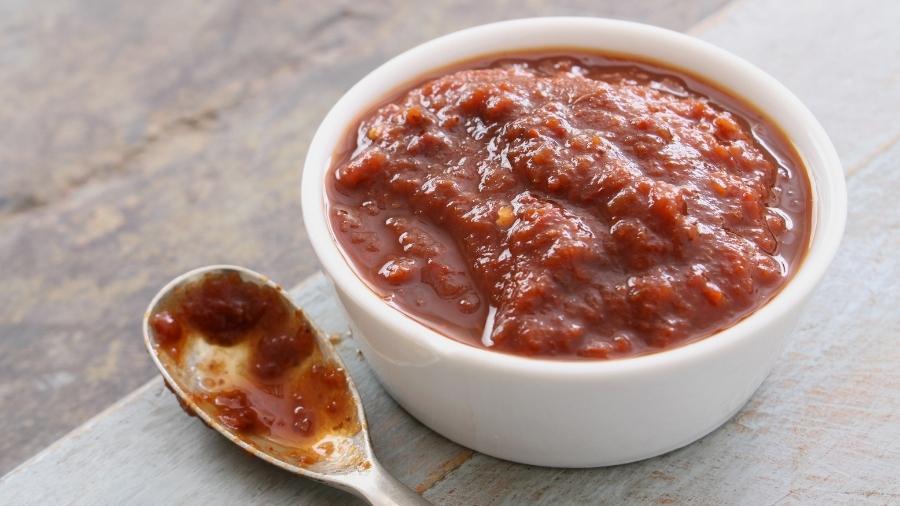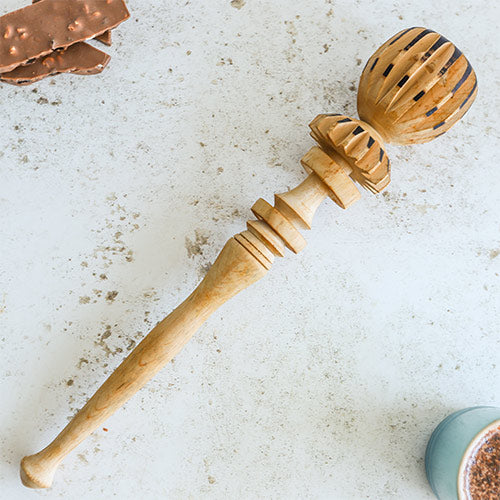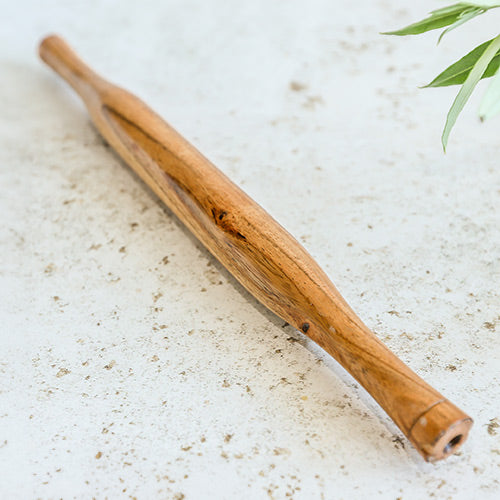1. Mango Chutney Recipe
Mango chutney can be served with Dosa, Idli, poppadom, and rice. In Indian restaurants, mango chutney comes from the kitchen in a Katori alongside mango lime pickle, yoghurt based mint sauce. It goes with mixed onion and coriander salad to top the crispy poppadom. This chutney is a gluten-free, spiced savoury condiment that originated in India. Chutneys are a type of sauce that can be made with various fruits, vegetables, and herbs with the addition of vinegar, sugar, and spices. Chutney is a condiment that can balance specific flavours in any dish. The history of Mango chutney; A 19th century British Army officer invented the word.
The chutney was made with these ingredients before the 19th century: mango, raisins, vinegar, lime juice, onion, tamarind extract, sweetener and spices. A person who derived the word Mango chutney and an Indian cook named Madhur Jaffrey invented it 40 years ago. It had an attribute of mango, cumin and fennel seeds which helped with better digestion, and it had some black mustard seeds. Fruity mango chutney is sweet.
For a serving, it is recommended to eat only a spoonful alongside the main meal. If the mango chutney is too sweet, the flavour can be countered by adding salt to taste. The shop brought chutney is preserved because of the high sugar content and will typically last up to 2 months in the fridge. A clear sign that it has gone off is if it tastes sour or fizzy.
Mango chutney is an Indian dish that everyone loves. It can be served with meat such as chicken, lamb, or pork. Also, mango chutney can be basted over boneless chicken breast and baked until cooked. Mango chutney and cheese is a classic combination.
Ingredients
- Medium size Juicy Semi Riped Mangoes ( 2 )
- Groundnut / Vegetable Oil (1 tablespoon)
- Ginger ( 1/2 grated or finely chopped )
- Red Chili Powder ( 1/4 Teaspoon )
- Garam Masala Powder ( 1 pinch )
- Asafoetida ( 1 Pinch )
- Salt ( Required )
- Powdered Jaggery ( 2 tablespoons) or Adjust as per the sweetness of the mangoes
- Panch Phoran ( 1/2 teaspoon ) - its an equal mix of cumin, fennel, mustard, nigella & fenugreek seeds
Method
- Peel & finely chop the ripe mangoes.
- If mangoes are very juicy and fibrous, you can remove the pulp.
- let us heat the oil in the pan and fry the Panch Phoran spices till fragrant Now, add ginger and fry for some seconds till its raw aroma goes away
- Add the finely chopped mango puree, then add the red chilli powder, garam masala powder and asafoetida.
- Simmer the hear for 1-2 minutes, then add the powdered Jaggery and salt. Stir it to cook for 2- 3 minutes. Do not overcook the mixture. Then it will become thick in texture.
- Remove the chutney to a bowl. Serve mango chutney warm or at room temperature as a dip or spread. The chutney stays suitable for 2-3 days in the refrigerator.
2. Coconut chutney recipe

Coconut chutney originated in South India. Coconut chutney was supposedly invented by a British officer who came to India. The date this chutney was created is unclear due to various internet sources claiming different dates. While this chutney's history is unknown, it has remained a popular chutney to serve alongside idli, dosa, Meda Vadu, and more.
Ingredients
- Grated coconut (70g)
- Gram flour (2 tbsp)
- Garlic (1)
- Chilli (to taste)
- Salt (1/4 tsp)
- Cumin seeds (1/2 tsp)
- Water (1/3 cup)
- Fresh coriander (handful)
- Lemon juice (half a lemon)
Seasoning
- Oil (1 tsp)
- Red chilli (1)
- Curry leaves
- Black mustard seeds (1/4 tsp)
- Asafoetida (pinch)
Method
- Add coconut, garlic, cumin, chillies, salt, and fried gram to a blender.
- If you don't have fried gram, then dry roast peanuts until they are golden in colour.
- Let all of the ingredients cool, then add to a jar.
- Blend all the ingredients without water; this will help to produce a smooth chutney.
- Once everything is soft, begin pouring water in as it is needed.
- Taste it and add more salt & chillies if needed. Transfer the Indian relish to a serving bowl.
- Heat a pan with the oil, then add the black mustard seeds. When the mustard seeds crackle and pop, add in the red chilli and curry leaves. After the curry leaves have gone crispy, add the pinch of asafoetida, pour this mixture over your coconut chutney, and serve it with idli, dosa, vada, or Pongal.
Is coconut chutney good for you?
While coconuts are well known for their high levels of saturated fat, this coconut chutney can be consumed as part of a healthy balanced diet. A recommended serving of coconut chutney is one tablespoon and eating more than this may cause you to overeat sodium for the day.
3. Tomato chutney recipe

Tomato Chutney is an easy dish to prepare. Many households throughout India will make it often. Tomato chutney is the best companion with rice, chapati & dosa. It can also be eaten with chicken and mutton. Tomato chutney has tomato chunks and crunchy mustard seeds.
In south Indian restaurants, especially villages, tomato chutney is often prepared for every meal. It is also served with Dosa, Poori, a bowl of rice, and Indian thali (A complete Indian meal). Tomato chutney has been a mass-produced product in the United States. Gordon & Dilworth produced Tomato chutney in New York in the 1890s and exported some products. The chutney combines sweetness and spicy flavours.
Ingredients
- Large tomatoes (2)
- Garlic Clove (2)
- Urad Dal (1 tbsp)
- Oil (2 tbsp)
- Chana Dal (1 tbsp)
- Fenugreek Seeds (1/4 tablespoon)
- Kashmiri Dried Red Chili (3)
- Turmeric (1/4 tbsp)
- Sugar ( 1/2 tbsp)
- Salt to taste
Ingredients For Tempering
- Oil (2 tbsp)
- Mustard Seeds (1/2 tbsp)
- Urad Dal (1/2 tbsp)
- Asafoetida (Pinch)
- Curry Leaves (Few)
Method
- In a large Kadai heat, the oil then adds urad dal, chana dal, fenugreek and red chilli. Adding few seeds of fenugreek will give a taste to the chutney. Saute them on medium heat until dal turns golden brown, then after some time, add garlic.
- Then, add chopped tomatoes and continue to saute until the water evaporates entirely and reduces the tomato size. After that, add turmeric powder, sugar and salt, then allow the mixture to cool completely, transfer to a smaller blender further, then blend to a smooth texture paste without adding any water.
- Prepare the tempering; heat the oil in a smaller Kadai. Once the oil is hot, add the mustard seeds, urad dal, hing and curry leaves.
- Let's allow the tempering to splutter and later, pour the tempering over the tomato chutney and finally, It's ready to be served with Rice, Idli or Dosa.
4. Green onion chutney recipe
This zingy, fresh, citrusy green onion chutney is the perfect accompaniment to poppadoms and mint sauce. It also pairs well with homemade scotch eggs and sweet mango chutney. We love this green onion chutney because of how much flavour it packs and how easy it is to make. Green onion chutney can be made with red onion or shallots. The key to making great chutney is to chop all of the ingredients as finely as possible. It can be blended; however, we prefer the texture of crunchy onion.
Most chutneys are full of sugar but not this one. Chutneys can be sweetened naturally by cooking, but this one is healthy, great for digestion, and requires no cooking. Raw onion is detoxifying, and with only four ingredients, this chutney is a great base for layering new flavours. You can add other ingredients depending on what you are serving it with; for example, add chilli to the chutney to add spice to your food. Alternatively, add finely chopped raw garlic, fresh parsley, and olive oil to give a more contrasting flavour to an Italian dish.
Ingredients
- Large onion (1)
- Fresh mint or coriander (2 tsp)
- Spring onion (2 tsp)
- Lemon juice (1 tsp)
Method
This chutney is so easy to make, mix everything and serve. If you want to, you can leave the chutney for a few hours in the refrigerator to let the flavours infuse.
5. Lemon pickle recipe

Lemon pickle is a popular condiment used in Indian cuisines and the subcontinent of Africa. It is similar to mango lime pickle but slightly varies in the taste despite its tangy flavour. The pickle is perfect for health as it is a natural Source of probiotics and contains nutrients such as copper, potassium, iron and calcium.
The main health benefit of this pickle is how it can improve the health of the digestive system. This pickle is typically served with samosa, dosa, and sometimes it will be on the side of the main curry. The green chilli listed in the ingredients is optional, so if you are not into spicy food, don’t add it.
Ingredients
- Large lemons (5)
- Bicarb of soda (1 tsp)
- Vinegar (900ml)
- Salt (1 tsp)
- Sugar (1 tbsp)
- Finely chopped garlic (1 large clove)
- Cooking oil (450 ml)
- Fresh green chillies (115g) (optional)
Spices
- Turmeric (1 tsp)
- Ground cumin (1 tsp)
- Chilli powder (1 tsp)
- Garam masala (1 tsp)
- Paprika (2 tsp)
Day 1
Pierce at the stalk end once, put into a pan of boiling water, add the bicarb of soda and simmer for 30 minutes and test if the skins are tender. If not, cook a little longer. Drain and remove from the pan, cut up into small pieces once cooled. Put 600ml of vinegar, salt and sugar into a pan and bring it to a boil; stir well. Add the lemons and cook for 10 minutes. Place into a non-metal bowl and stand overnight.
Day 2
Mix the garlic and spices into a paste with the remaining vinegar. Boil 300ml of oil remove it from the hob for 3 minutes before adding the spice paste. Stir over heat until the vinegar dries out and the oil comes to the surface. Add lemon, chillies and rest of the vinegar and cook until the vinegar boils out again and the oil comes to the top, put aside to cool slightly.
Boil the remaining oil and lightly warm screw-top jars in the oven to ensure they are dry. Fill the jar with pickle - pouring some of the hot oil on top to seal the jar. Cover with greaseproof paper and put on the caps, leave for at least one month, and it will last indefinitely.
6. Fresh chilli chutney recipe
This is a fresh chutney because the chillies are chopped, and everything only comes together when you are about to serve. It is a simple way to add a bit of heat and flavour to your meal whilst also giving it a kick of health with fresh uncooked ingredients. Chilli, lemon, fresh herbs, and ginger are all ingredients that will provide some health benefits. I like to make this with mild mixed chillies, that way you get the flavour from the pepper without it overpowering the meal.
The chilli chutney is extremely tasty, with herby flavours and a sweet zingy flavour. The lemon juice kind of cooks the raw chutney, and a spoonful of this over a plain tomato pasta will really bring it to life. It would pair well with prawns and could easily be added to a seafood sauce or put some on homemade flatbread or poppadom to enhance the flavour. This fresh chilli chutney can be made in as little or as 5 minutes or less, it is simplicity at its best. The type of herbs you use are very forgiving, we have tried this with mint, parsley and coriander and the best comes down to your personal preference, our favourite is coriander because we love the freshness that it brings.
Ingredients
- Green or red chilli (1/2 cup)
- Chopped fresh mint, parsley or coriander (1/2 cup)
- Lime or lemon juice (1 tbsp)
- Fresh ginger (1 tsp)
- Salt
Method
Wash the chillies, then cut off the stalks and finely chop them. Chop the fresh mint and ginger, then mix the rest of the ingredients 20 minutes before serving.
7. Raita yoghurt chutney recipes

The term raita means yoghurt chutney, and it is perfect when serving with something on the spicy side. Yoghurt is cooling, and every time your mouth is burning up, you can go back to that soothing yoghurt. Our favourite variation is cucumber raita which we have on the side of jerk chicken, fajitas, curry and more.
There are many variations of yoghurt chutney, and I list them at the bottom of this article. For now, see the recipe for the basic chutney, and feel free to adjust it to your taste.
Ingredients
- Natural yoghurt (1 cup)
- Salt
- Pepper
- Freshly chopped coriander
- Nutmeg (pinch)
Method
If your yoghurt is watery, start by draining off the excess liquid. To make the yoghurt chutney, simply combine all ingredients but garnish with the nutmeg and coriander. Now let’s explore the other raita yoghurt combinations.
Mixed raita
Add finely chopped cucumber, a small onion, a tomato, and a teaspoon of chopped fresh ginger, then garnish with coriander.
Date and raisin raita
Finely chop a handful of dates and a tablespoon of raisins, then add to plain natural yoghurt.
Cucumber raita
Peel and finely chop a 5cm piece of cucumber and add it to the natural yoghurt if you want to make it extra cool add some fresh mint.
Mint raita
Add about 1 tsp of fresh chopped mint to the natural yoghurt. Simple but fresh.
Garlic raita
Using the same ingredients as the plain raita, adding one finely chopped or crushed raw garlic clove.
Potato raita
This is the Indian equivalent of a potato salad but without the mayonnaise and heaviness. Make the plain raita but add a peeled cubed cooled boiled potato to the plain raita.
Looking for the Best Chutneys to Buy?
If you’re inspired by these recipes but don’t have time to make your own, explore the unique flavours of Mr Vikki’s chutneys. They offer a range of small-batch chutneys that have an authentic taste with quality ingredients. Perfect for any meal, these chutneys are a delicious, easy way to add a burst of flavour to your plate. Check out Mr Vikki's selection and find your new favourite chutney!











